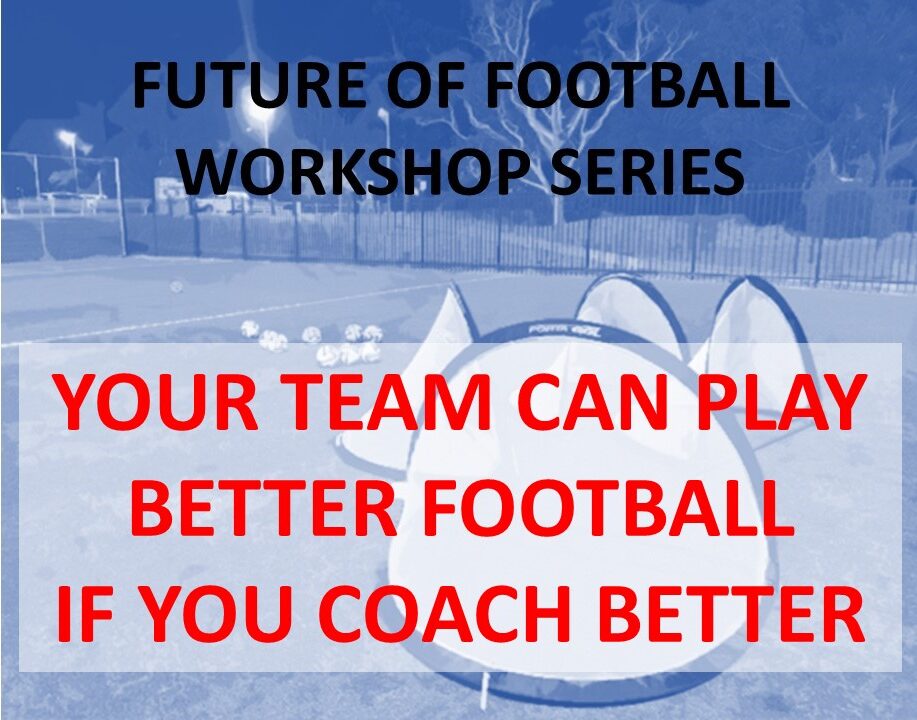MWFA recently ran a series of interactive workshops for coaches interested in where the future of football is heading, especially in youth development. There are people’s opinions, and there is logical debate, but sometimes even these are not enough for people to be convinced. To resolve this dilemma, we conducted experiments to prove how certain things should be approached using grassroots players, factual data and first hand experiences.
In this third workshop, the theme was: “YOUR TEAM CAN PLAY BETTER FOOTBALL IF YOU COACH BETTER”.
We had several groups of different ages and skill levels, initially playing without coaching to see their natural behaviour, and then seeing how far we could take them with effective coaching.
The ‘effective coaching’ involved:
- Demonstration and moving pictures for the players to visualise different scenarios
- Using Q&A to trigger problem solving and discussion
- Giving them key phrases and cues to help them recognise their options, as well as reminders on the run to help them reflect
- Positive reinforcement to encourage more of the same behaviour from the player concerned and all other players
The above replaces more typical and less effective methods of coaching, such as talking without helping the players see what you mean, talking for too long (leading to information overload and reduced playing time), not engaging the players and only telling them what to do (no decision making), and only offering negative correction, which impacts the degree with which players have a positive experience at training.
Feedback provided to the players was focused on:
- Using their first touch to move the ball (ideally forwards, or at least away from the nearest defender)
- Not rushing on the ball even if under pressure, and supporting each other off-the-ball to provide options
- Recognising when space is limited and seeing if there is a teammate free on the other side of the pitch, and what players could say to each other to make this work
Obviously, the level of detail and language used was adapted to each group, but the messages were the same philosophically.
We measured the following stats for each group before being coached, while being coached, and after being coached:
- Switching play (successful pass to teammate on opposite wing)
- Turn-overs (booting it, getting tackled, being forced out, etc.)
- Scoring chances (shots on and off target, 1v1 against the goalie, etc.)
- Consecutive passes (passes in a row before a shot or turn-over)
We kept this experiment as objective as possible by ensuring the following:
- Using the exact same process with different age groups
- Regularly mixing up teams based on levels of ability and gender within each age group
- Every team played the same duration, using a different size field and number of players depending on their age group
- We had the same number of analysts watching each team and group
Obviously, doing a longer term comparison would be better, but the results from just one night were very insightful. Note that the data from game 2 is not as important because the duration of this game was different, and players were adapting as they were learning and being challenged with each new coaching point. The important comparison is between game 1 (before being coached) and game 3 (after being coached).
The raw data is shown in the following table:

What we can see is that players were able to perform 31% better overall in game 3 (where they could play freely again, but after being coached) according to the criteria we were analysing. In other words, they switched play successfully more often (39% more often), lost the ball less often (by 29%), and created more scoring chances (24%). Interestingly, despite these findings, the number of consecutive passes was 18% worse on average in game 3 for most age groups, but when this is analysed with the other stats in mind, it is likely because players were playing more effectively (switching play and creating scoring chances) using fewer passes, rather than passing more often but getting stuck in crowded areas and losing the ball.
Conclusions / Reflections / Learnings:
- If you can have a 31% positive impact in one session with any age group and level of players, imagine how much of an impact you can have over a whole season using these teaching methods. If demonstrating, asking questions and/or highlighting role models are not methods of coaching you are used to, the only thing you can do is start, and the more you practice the better you will get (just like players learning new skills).
- If you can have this much of an impact in a purely game-based training session with no restrictions or conditions, why bother doing anything else? The most important aspect of any training exercise is if the learning transfers into real matches, and the best way to ensure this occurs in real matches is practising during training sessions (if you do anything else, you are only assuming and hoping the learning will transfer).
- The counter-argument to the previous point, which was covered in the first workshop, is that game-like drills allow for more repetition of specific skills. The lesson is to keep these simple and realistic, and focus more on coaching effectively during these drills, rather than getting distracted with managing the rules and progressions in the drill. Spend more time playing football in your training sessions, give the players challenges and feedback while they play – if any drills are not giving you higher success when the players try the same things in match scenarios, don’t bother with them.
MWFA would like to thank all of the players and coaches who participated in these workshops for their time.


